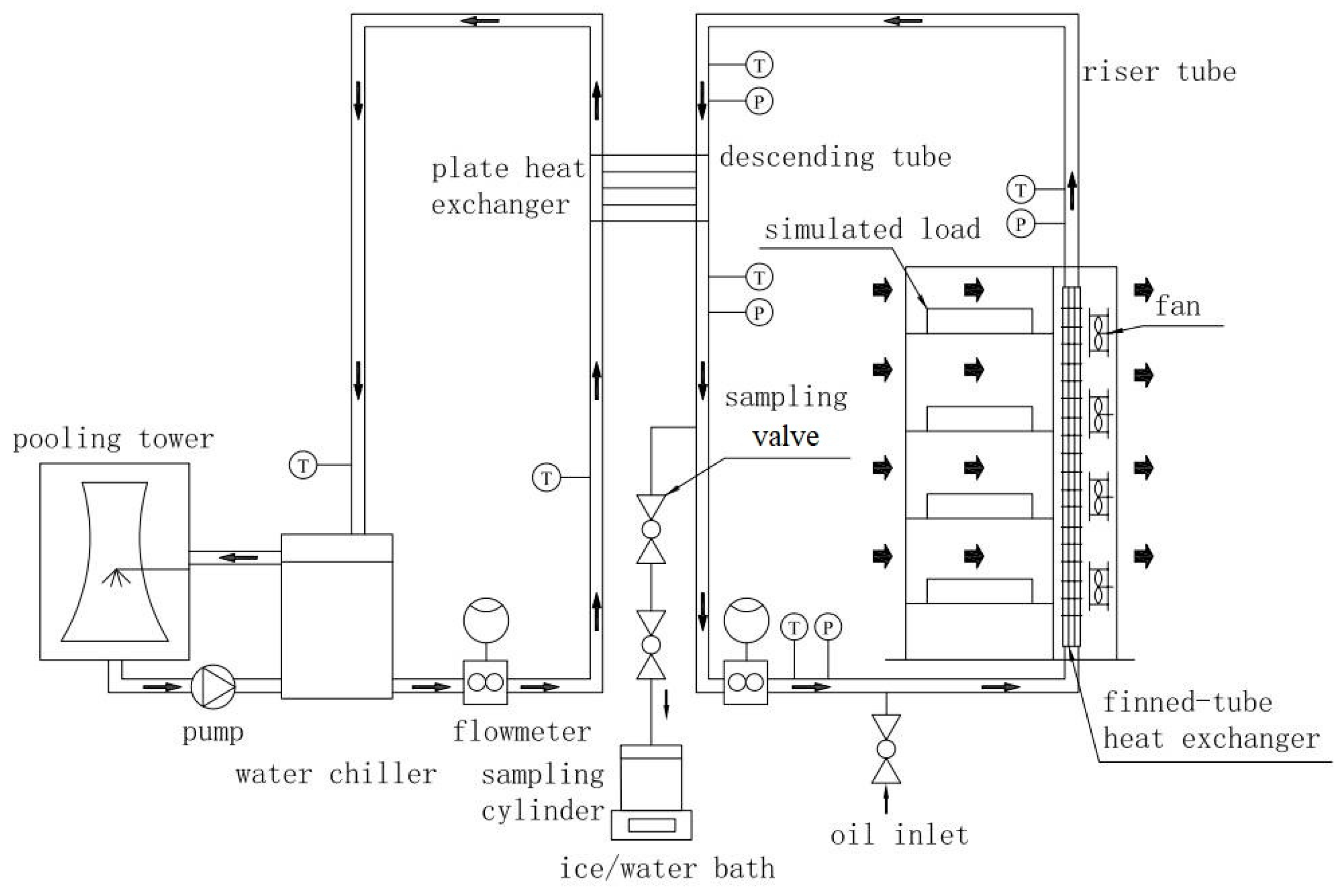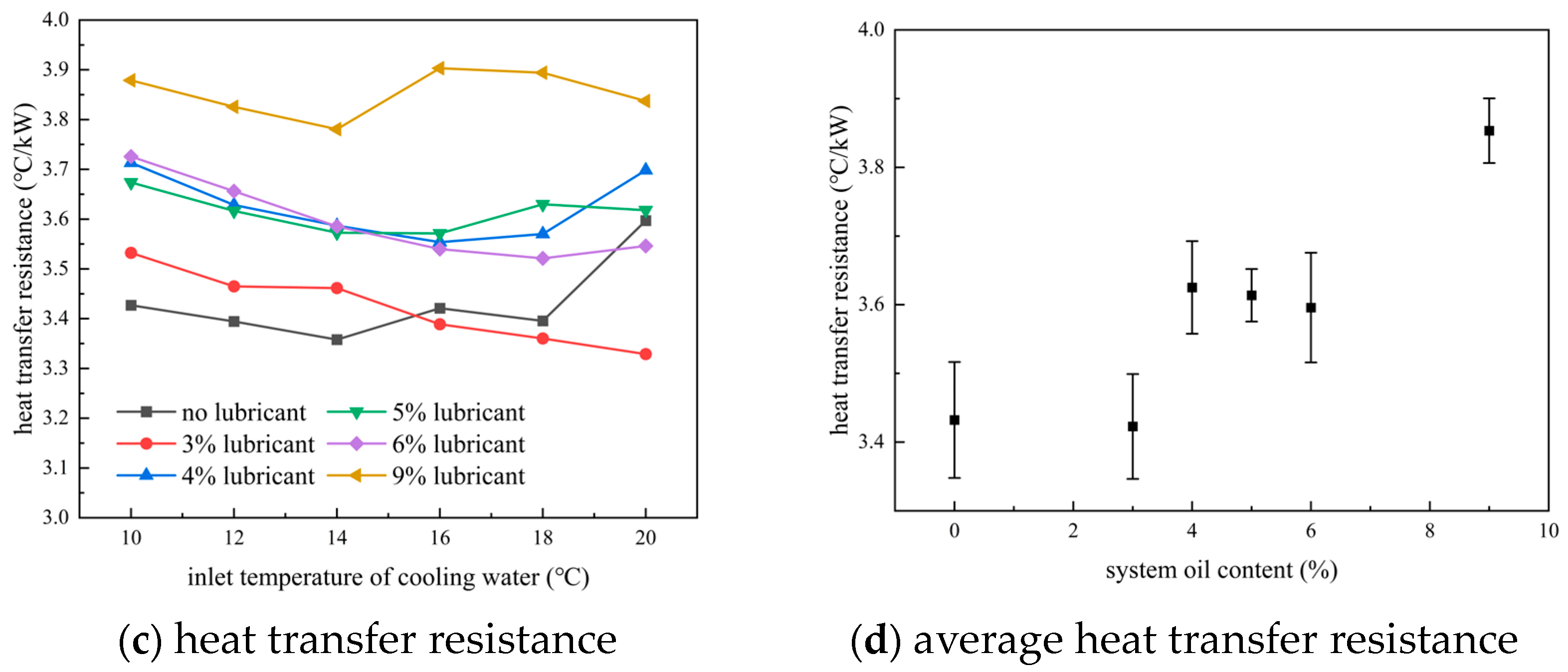Experimental Study on the Impact of Lubricant on the Performance of Gravity-Assisted Separated Heat Pipe
Abstract
:1. Introduction
2. Experiment
2.1. Experimental System
2.2. Experimental Procedure
2.3. Experimental Data Processing
3. Results and Discussions
3.1. Oil-Free Case
3.2. Lubricant-Influenced Performance with Sufficient Refrigerant Charge
3.3. Performance with Lubricant and Insufficient Refrigerant Charge
3.4. Discussions
4. Conclusions
Author Contributions
Funding
Data Availability Statement
Conflicts of Interest
References
- Alkrush, A.A.; Salem, M.S.; Abdelrehim, O.; Hegazi, A.A. Data centers cooling: A critical review of techniques, challenges, and energy saving solutions. Int. J. Refrig. 2024, 160, 246–262. [Google Scholar] [CrossRef]
- Xu, S.; Zhang, H.; Wang, Z. Thermal Management and Energy Consumption in Air, Liquid, and Free Cooling Systems for Data Centers: A Review. Energies 2023, 16, 1279. [Google Scholar] [CrossRef]
- Zhu, H.; Zhang, D.; Goh, H.H.; Wang, S.; Ahmad, T.; Mao, D.; Liu, T.; Zhao, H.; Wu, T. Future data center energy-conservation and emission-reduction technologies in the context of smart and low-carbon city construction. Sustain. Cities Soc. 2023, 89, 104322. [Google Scholar] [CrossRef]
- Wang, X.; Wen, Q.; Yang, J.; Xiang, J.; Wang, Z.; Weng, C.; Chen, F.; Zheng, S. A review on data centre cooling system using heat pipe technology. Sustain. Comput. Inform. Syst. 2022, 35, 100774. [Google Scholar] [CrossRef]
- Tong, Z.; Han, Z.; Fang, C.; Wen, X. Two-phase thermosyphon loop with different working fluids used in data centers. Int. J. Heat Mass Transf. 2023, 214, 124393. [Google Scholar] [CrossRef]
- Cao, J.; Zheng, Z.; Asim, M.; Hu, M.; Wang, Q.; Su, Y.; Pei, G.; Leung, M.K. A review on independent and integrated/coupled two-phase loop thermosyphons. Appl. Energy 2020, 280, 115885. [Google Scholar] [CrossRef]
- Zhang, H.; Shao, S.; Tian, C.; Zhang, K. A review on thermosyphon and its integrated system with vapor compression for free cooling of data centers. Renew. Sustain. Energy Rev. 2018, 81, 789–798. [Google Scholar] [CrossRef]
- Okazaki, T.; Seshimo, Y. Cooling System Using Natural Circulation for Air Conditioning. Trans. Jpn. Soc. Refrig. Air Cond. Eng. 2008, 25, 239–251. [Google Scholar]
- Han, L.; Shi, W.; Wang, B.; Zhang, P.; Li, X. Energy consumption model of integrated air conditioner with thermosyphon in mobile phone base station. Int. J. Refrig. 2014, 40, 1–10. [Google Scholar] [CrossRef]
- Zhang, H.; Shao, S.; Zou, H.; Tian, C. Performance analysis on hybrid system of thermosyphon free cooling and vapor compression refrigeration for data centers in different climate zones of China. Energy Procedia 2014, 61, 428–431. [Google Scholar] [CrossRef]
- Wang, Z.; Zhang, X.; Li, Z.; Luo, M. Analysis on energy efficiency of an integrated heat pipe system in data centers. Appl. Therm. Eng. 2015, 90, 937–944. [Google Scholar] [CrossRef]
- Lamptey, N.B.; Anka, S.K.; Lee, K.H.; Cho, Y.; Choi, J.W.; Choi, J.M. Comparative energy analysis of cooling energy performance between conventional and hybrid air source internet data center cooling system. Energy Build. 2024, 302, 113759. [Google Scholar] [CrossRef]
- Meng, F.; Zhang, Q.; Lin, Y.; Zou, S.; Fu, J.; Liu, B.; Wang, W.; Ma, X.; Du, S. Field study on the performance of a thermosyphon and mechanical refrigeration hybrid cooling system in a 5G telecommunication base station. Energy 2022, 252, 123744. [Google Scholar] [CrossRef]
- Zhang, H.; Shao, S.; Xu, H.; Zou, H.; Tang, M.; Tian, C. Simulation on the performance and free cooling potential of the thermosyphon mode in an integrated system of mechanical refrigeration and thermosyphon. Appl. Energy 2017, 185, 1604–1612. [Google Scholar] [CrossRef]
- He, Z.; Xi, H.; Ding, T.; Wang, J.; Li, Z. Energy efficiency optimization of an integrated heat pipe cooling system in data center based on genetic algorithm. Appl. Therm. Eng. 2021, 182, 115800. [Google Scholar] [CrossRef]
- Meng, F.; Zhang, Q.; Zou, S.; Zhu, X.; Liu, L.; Chen, S. Operating parameters optimization of a thermosyphon and compressor system used in 5G TBS. Appl. Therm. Eng. 2024, 241, 122331. [Google Scholar] [CrossRef]
- Fu, R.; He, Z.; Zhang, X. Life cycle cost based optimization design method for an integrated cooling system with multi-operating modes. Appl. Therm. Eng. 2018, 140, 432–441. [Google Scholar] [CrossRef]
- Zhang, P.; Shi, W.; Li, X.; Wang, B. Effect of lubricating oil on the performance of two-phase natural circulation. In Proceedings of the 13th National Conference on Refrigerator, Air Conditioner and Compressor, Foshan, China, 9–10 December 2016. (In Chinese). [Google Scholar]
- GB 50174-2017; Code for Data Center Design. Ministry of Housing and Urban-Rural Development of the People’s Republic of China: Beijing, China, 2017.
- GB/T 5773-2016; Test Mothod for the Performance of Displacement Refrigeration Compressor. General Administration of Quality Supervision, Inspection and Quarantine of the People’s Republic of China: Beijing, China, 2016.
- Li, W.; Hrnjak, P. Transient refrigerant and oil distribution in a residential heat pump water heater system: Experiments and model. Int. J. Refrig. 2021, 129, 184–193. [Google Scholar] [CrossRef]
- Zhang, P.; Shi, W.; Li, X.; Wang, B.; Zhang, G. A performance evaluation index for two-phase thermosyphon loop used in HVAC systems. Appl. Therm. Eng. 2018, 131, 825–836. [Google Scholar] [CrossRef]
- Ding, T.; He, Z.; Hao, T.; Li, Z. Application of separated heat pipe system in data center cooling. Appl. Therm. Eng. 2016, 109, 207–216. [Google Scholar] [CrossRef]
- Zou, S.; Zhang, Q.; Yue, C.; Wang, J.; Du, S. Study on the performance and free cooling potential of a R32 loop thermosyphon system used in data center. Energy Build. 2022, 256, 111682. [Google Scholar] [CrossRef]
- Shen, B.; Groll, E.A. Review article: A critical review of the influence of lubricants on the heat transfer and pressure drop of refrigerants, Part I: Lubricant influence on pool and flow boiling. HVACR Res. 2005, 11, 341–359. [Google Scholar] [CrossRef]
- Shen, B.; Groll, E.A. A critical review of the influence of lubricants on the heat transfer and pressure drop of refrigerants—Part II: Lubricant influence on condensation and pressure drop. HVACR Res. 2005, 11, 511–526. [Google Scholar] [CrossRef]







| Structure Parameters of the Evaporator | Value | Structure Parameters of the Condenser | Value |
|---|---|---|---|
| Outer diameter, mm | 7 | Length of the plate, mm | 525 |
| Tube wall thickness. mm | 0.24 | Width of the plate, mm | 107 |
| Fin thickness, mm | 0.11 | Chevron angle, ° | 65 |
| Space between neighbored fins, mm | 1.5 | Thickness of the plate, mm | 0.4 |
| Space between neighbored columns, mm | 21 | Pitch of the chevron, mm | 7 |
| Space between neighbored rows, mm | 18 | Height of the chevron, mm | 2 |
| Tube length, mm | 1800 | Heat exchange area per plate, m2 | 0.5 |
| Column number of tube | 17 | Section area for single channel, mm2 | 206 |
| Number of tube rows | 4 | Number of plates | 24 |
| Properties | Value |
|---|---|
| Viscosity/40 °C mm2⋅s−1 | 45.3 |
| Viscosity/100 °C mm2⋅s−1 | 7.1 |
| Density/20 °C g⋅cm−3 | 0.977 |
| Pour Point/°C | −46 |
| Flash Point/°C | 260 |
| Water Content/ppm | <40 |
| Acid Value/mg KOH⋅g−1 | 0.02 |
| Parameter | Type | Range | Precision |
|---|---|---|---|
| Temperature | PT100 platinum resistor (Xiamen Mingcon Instrument Co., Ltd., Xiamen, China) | −50~500 °C | ±0.1 °C |
| Pressure | Pressure transmitter (Xuan Sheng Instrument Technology Co., Ltd., Suzhou, China) | 0~5 MPa | ±0.2% |
| Air velocity | Hot wire anemometer (Testo SE & Co. KGaA, Shenzhen, China) | 0~30 m/s | ±0.1 m/s |
| Refrigerant mass flow rate | Coriolis mass flowmeter (Micro Motion, Inc., Boulder, CO, USA) | 0~0.378 kg/s | ±0.2% |
| Water flow rate | Electromagnetic flowmeter (Shanghai Micro Condition Measurement and Control Technology Co., Ltd., Shanghai, China) | 0~17.671 m3/h | ±0.2% |
| Fan power | Power meter (Ningbo Gigh-tech Zone Xincheng Electronics Co., Ltd., Ningbo, China) | 0~2500 W | ±0.1% |
| Oil mass | Balance (Kunshan Scale Electronic Technology Co., Ltd., Ruian, China) | 0~500 g | 1 mg |
| Refrigerant mass | Balance (Zhejiang Value Mechanical & Electrical Products Co., Ltd., Hangzhou, China) | 0~5000 g | 10 mg |
| Parameter | Range |
|---|---|
| Refrigerant charge (kg) | 3.5, 4.0, 4.5, 5.0 |
| Cooling water temperature (°C) | 10, 12, 14, 16, 18, 20 |
| Lubricant concentration (%) | 0, 3, 6, 9 |
| Air flow rate of the evaporator (m3/h) | 3200 |
| Volume flow rate of cooling water (m3/h) | 1.35 |
Disclaimer/Publisher’s Note: The statements, opinions and data contained in all publications are solely those of the individual author(s) and contributor(s) and not of MDPI and/or the editor(s). MDPI and/or the editor(s) disclaim responsibility for any injury to people or property resulting from any ideas, methods, instructions or products referred to in the content. |
© 2024 by the authors. Licensee MDPI, Basel, Switzerland. This article is an open access article distributed under the terms and conditions of the Creative Commons Attribution (CC BY) license (https://creativecommons.org/licenses/by/4.0/).
Share and Cite
Rongyang, Y.; Su, W.; Mao, Z.; Huang, W.; Du, B.; Zhang, S. Experimental Study on the Impact of Lubricant on the Performance of Gravity-Assisted Separated Heat Pipe. Energies 2024, 17, 3772. https://doi.org/10.3390/en17153772
Rongyang Y, Su W, Mao Z, Huang W, Du B, Zhang S. Experimental Study on the Impact of Lubricant on the Performance of Gravity-Assisted Separated Heat Pipe. Energies. 2024; 17(15):3772. https://doi.org/10.3390/en17153772
Chicago/Turabian StyleRongyang, Yiming, Weitao Su, Zujun Mao, Wenlin Huang, Bowen Du, and Shaozhi Zhang. 2024. "Experimental Study on the Impact of Lubricant on the Performance of Gravity-Assisted Separated Heat Pipe" Energies 17, no. 15: 3772. https://doi.org/10.3390/en17153772






